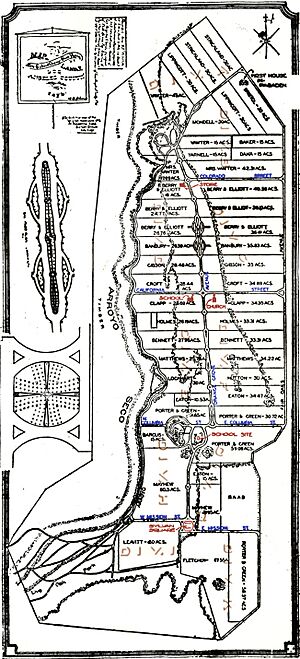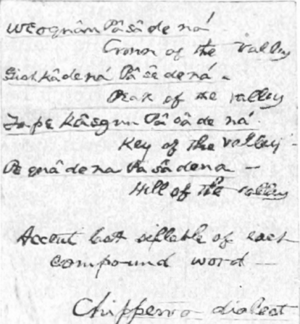Indiana Colony facts for kids
Quick facts for kids
The Indiana Colony
|
|
|---|---|
|
Agricultural settlement
|
|
| State | California |
| County | Los Angeles |
| Organized | July 8, 1873 as California Colony of Indiana |
| Certified | January 27, 1874 as San Gabriel Orange Growers Association |
| Post Office granted | August, 1876 to Pasadena |
| Founded by | Thomas Balch Elliot |
The Indiana Colony was the first name for the area we now call Pasadena, California, in the United States. It was also the name of the group of people who first settled there. This group was officially formed on January 31, 1874. They were people from Indiana who wanted to move to a warmer place. They had just gone through a very cold winter in 1872–73.
The settlers first met at the home of Thomas Elliott. They chose Daniel Berry to travel to Southern California. His job was to find good land at a fair price.
Berry visited several places like San Diego, Anaheim, and San Fernando. He also looked at Rancho Santa Anita and Rancho San Pascual. He met Judge Benjamin Eaton and Benjamin Davis "Don Benito" Wilson. He was able to buy land in the eastern part of Rancho San Pascual. This land was near the Arroyo Seco.
A financial crisis in 1873, called the Panic of 1873, made some early investors pull out. Berry quickly changed the company name to the San Gabriel Orange Grove Association. He found new people who wanted to invest. This helped save the plan to buy the land.
The property was nearly 4,000-acre (16 km2) (about 16 square kilometers). This land became The Indiana Colony. It was the beginning of what is now Pasadena, California.
Contents
Why People Moved West
In 1873, the Midwest had a very harsh winter. Many people in Indianapolis wanted to move to a warmer place. They dreamed of living among citrus trees and flowers that bloomed all year. The Transcontinental Railroad had been finished in 1869. This made moving west much easier and cheaper.
A group of neighbors met at the home of Dr. and Mrs. Thomas Elliott. Mrs. Elliott's brother, Daniel M. Berry, was there. They first talked about the idea of moving west.
Daniel Berry's Role
Daniel Berry was a former teacher who became a journalist. He was also interested in his brother-in-law's farm. Berry had asthma, and the cold Midwestern weather made him feel worse. He contacted Harris Newmark, who had recently bought Rancho Santa Anita. Newmark gave him helpful information about Southern California.
Newmark even visited Indianapolis and told the Elliotts and their friends about California. After that meeting, the group from Indiana formed "The California Colony of Indiana." It didn't take long to find enough members for the group.
The next step was to explore properties in California.
Finding the Perfect Land
Daniel Berry was chosen from a committee of four people. His job was to scout land in Southern California for the Indianapolis investors. He visited five areas: San Diego, Anaheim, San Fernando, Rancho Santa Anita, and Rancho San Pascual. He was told to try and buy land for about $5 per acre.
Exploring Different Locations
San Diego seemed like a good place, and the price was right. But they would need many windmills to pump water. The company decided against it. Berry thought San Bernardino was too hot. In Anaheim, he didn't like the many fleas or the "musketers" (people carrying guns).
He said San Fernando's price of $2 per acre was good. However, the area was only good for growing grain. There wasn't enough water for growing citrus fruits. The Indiana settlers really wanted to grow fruit orchards.
Rancho Santa Anita included the lands of today's Arcadia, Monrovia, Duarte, El Monte, and Baldwin Park. This property had everything needed for growing citrus. But it was too expensive at $20 per acre.
Discovering Rancho San Pascual
On September 12, 1873, Berry met Judge Benjamin Eaton. Eaton represented Dr. John S. Griffin, who owned the Fair Oaks Ranch. This ranch was on Rancho San Pascual. Berry said he had his first good night's sleep in years there. He loved Rancho San Pascual. To keep his discovery a secret, he gave the place a secret name: "Muscat." He chose this name because of the many grapes growing on the hillsides.
Forming the San Gabriel Orange Growers Association
The land was offered for $10 per acre. But Dr. Griffin and Benjamin Wilson were having trouble dividing their properties. Berry wrote to Elliott, asking for money to buy what he could of Rancho San Pascual. It took two weeks for mail to go back and forth. So, it was September 19 before the news reached Indiana.
The company decided to offer $15 per acre, closer to the price of Santa Anita. But this deal didn't work out. First, the owner, Newmark, was not home. Second, the New York Stock Market had a financial panic. This ruined the money plans for the Indiana Colony.
A New Plan for Funding
Elliott kept a few of the original investors. He sent only $200 as a down payment for $25,000 worth of the Muscat property. Berry then became a promoter. He found more investors for the company under a new California name: "The San Gabriel Orange Growers Association." He sold 100 shares at $250 each. This helped save the company's ability to buy land.
As Griffin and Wilson settled their land divisions, the association bought a strip of 2,576 acres (10 km2) (about 10 square kilometers) near the Arroyo Seco. Griffin also offered an extra 1,386 acres (6 km2) (about 5.6 square kilometers) to the Colony. He had received this land from Wilson for free and without taxes. This was seen as a kind gesture. However, it was actually land that was considered worthless highland property. This land would later become Altadena. The lower part of the land became The Indiana Colony.
Renaming the Colony
The community lived happily under its first name until 1876. At that time, the people wanted their own post office. For two and a half years, mail was brought from Los Angeles by a resident's son who went to school there. Mail for the colony was sent to Los Angeles marked "Indiana Colony." But when the community asked for a post office, the Postmaster General said no to their name.
This started the search for a new name for the community. Several other names were suggested, but the postal department in Washington rejected them all. Eventually, they accepted the name Pasadena.
The Meaning of Pasadena
When T. B. Elliott first came to the valley, Judge Eaton showed him around. Eaton mentioned that the land the Indiana Colony was on was the "key to the valley." This meant it was the easiest way to enter the valley. This made it simple to control who came in and out.
With this in mind, Elliott wrote to a friend who knew the Chippewa language very well. He asked for suggestions that sounded nice but also showed the special connection the spot had to the land around it. Each suggestion his friend sent back contained the word "pasadena." So, this was the name Elliott chose for the post office and the community.



